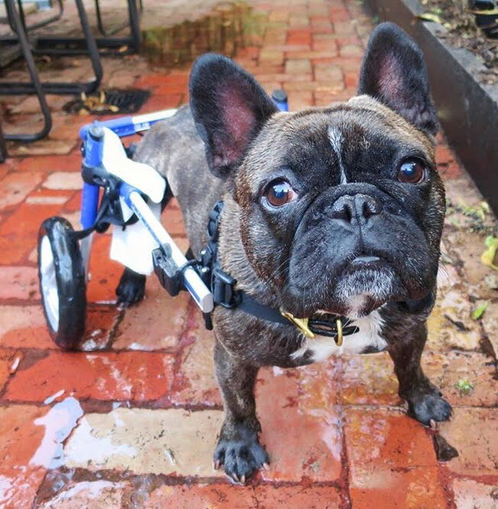Stem cell therapy for paralyzed dogs
Stem cell therapy is an emerging field of research providing hope for paralyzed people and dogs alike. We follow the journey of one paralyzed dog, Louis, as he undergoes experimental stem cell treatment at the University of Melbourne
The subject: Louis
First, a bit about Louis. At the age of five years old Louis suffered a herniated disc in his spine, a result of the genetic condition called intervertebral disc disease (IVDD).
Louis was taken to an emergency vet hospital at the first signs of wobbly hind legs. He very quickly progressed to being completely paralyzed with no deep pain perception. In Louis’ case CT scans revealed that an operation would not be beneficial. All we could do was rest and hope for some degree of recovery.
For the next year we attempted regular physiotherapy, hydrotherapy and acupuncture but did not see any signs of progress. Louis remains paralysed and we now expect there will be no improvement of his sutuation. Since then we have continued with acupuncture and home massage to keep his muscles and joints healthy, and electro-stimulation using a TENs unit.
Louis was taken to an emergency vet hospital at the first signs of wobbly hind legs. He very quickly progressed to being completely paralyzed with no deep pain perception. In Louis’ case CT scans revealed that an operation would not be beneficial. All we could do was rest and hope for some degree of recovery.
For the next year we attempted regular physiotherapy, hydrotherapy and acupuncture but did not see any signs of progress. Louis remains paralysed and we now expect there will be no improvement of his sutuation. Since then we have continued with acupuncture and home massage to keep his muscles and joints healthy, and electro-stimulation using a TENs unit.
How stem cell therapy works
In severe spinal cord trauma damage occurs to the neurons in the spinal cord and they subsequently die. The body cannot normally replace neurons once they die. This results in a loss of the pathways that transmit information along the spinal cord.
Stem cells are able to grow into many different types of cells and can continue to replicate and grow, repairing damage in the body. This research project is testing a new treatment for spinal cord trauma using neural-derived stem cells. These particular types of stem cells are more likely to form message-transmitting neuron cells. When injected into the damaged area the hope is that that message pathways can be rebuilt across the area of damaged spinal cord.
In this case the stem cells that will be used have been sourced from a human donor. Anti-rejection medication will need to be taken twice daily to prevent Louis’ immune system from attacking the foreign cells.
Stem cells are able to grow into many different types of cells and can continue to replicate and grow, repairing damage in the body. This research project is testing a new treatment for spinal cord trauma using neural-derived stem cells. These particular types of stem cells are more likely to form message-transmitting neuron cells. When injected into the damaged area the hope is that that message pathways can be rebuilt across the area of damaged spinal cord.
In this case the stem cells that will be used have been sourced from a human donor. Anti-rejection medication will need to be taken twice daily to prevent Louis’ immune system from attacking the foreign cells.
Initial consultation
The first step was an initial visit to the University of Melbourne veterinary hospital to meet the research team. They ran a range of neurological tests on Louis to confirm his condition, assess his general health, reflexes, joints, and deep pain perception in his hind legs. We discussed Louis bladder and bowel control (or lack of), the rehabilitation that we had attempted, and our general daily routine.
The neurologist confirmed what we already knew, Louis had little to no chance of recovery. With the most severe degree of paralysis and no real prospect of recovery, Louis was a good candidate for the trial. We spent some time discussing the trial in more detail, asking lots of questions about the procedure and the medication.
We returned home to read over the paperwork and consider the pro’s and con’s. Once we were happy for Louis to take part in the trial the research team reanimated the frozen cells and started Louis on the anti-rejection medication.
We returned home to read over the paperwork and consider the pro’s and con’s. Once we were happy for Louis to take part in the trial the research team reanimated the frozen cells and started Louis on the anti-rejection medication.
Cyclosporine medication
Cyclosporine is an effective immunosuppressant drug used by both human and animal transplant recipients. It works by reducing the function of the body’s immune system to prevent it from attacking the injected stem cells.
For Louis, the medication is given as an oral liquid. We began giving Louis the cyclosporine a week before the cells were injected. The dosage is 50 mg (1 mL of the liquid) twice a day and needs to be given at least an hour before food.
If the treatment improves Louis’ condition, and we want those benefits to continue, the cyclosporine medication would need to continue to be taken every day.
For the first few weeks the medication was taking its toll on Louis’ stomach. We were dealing with some fairly epic diarrhoea but he otherwise seemed fine. A dog-friendly Pepto Bismol kept it under control initially and his stomach now seems to tolerating it better.
For Louis, the medication is given as an oral liquid. We began giving Louis the cyclosporine a week before the cells were injected. The dosage is 50 mg (1 mL of the liquid) twice a day and needs to be given at least an hour before food.
If the treatment improves Louis’ condition, and we want those benefits to continue, the cyclosporine medication would need to continue to be taken every day.
For the first few weeks the medication was taking its toll on Louis’ stomach. We were dealing with some fairly epic diarrhoea but he otherwise seemed fine. A dog-friendly Pepto Bismol kept it under control initially and his stomach now seems to tolerating it better.
Implanting the cells
|
Louis spent two days at the Melbourne University animal hospital to undergo the cell implant procedure.
Day one started with an MRI under general anesthetic. The imaging found the area of damaged spinal cord which was reportedly ‘quite large’. The MRI showed that over the period of a year and a half since the damage occurred the spinal cord had effectively turned to a liquid in that area. Louis was then moved to the live X-ray machine where they injected the cells into the damaged section of spinal cord at a number of points. In total, the procedure took around three hours and went exactly as planned. Louis spent the night in the hospital to recover under observation. He recovered well and the following day Louis was put through a number of basic tests to measure his movement including being video recorded walking on a treadmill. Later that day he was ready to come home! |
Aside from being tired from a night without sleep in the animal hospital, Louis was completely fine and showed no signs of pain following the procedure. The slightly red area towards the bottom of the shaved section was the only sign of where the injections were made.
Expectations
We understand that this trial has been running for the past few years during which time several dogs have received the same stem cell transplant. While the research team can’t provide much information on the results from the other dogs, they have indicated that some signs of improvement have been reported.
While we would love for stem cells to be the magic bullet that can make Louis walk again the reality is that the improvements, if any, will probably be much more subtle. For us we would love to see some improvement to bladder and bowel control. Ultimately, we are just excited to be part of important research that might one day lead to an effective treatment for spinal cord injury.
While we would love for stem cells to be the magic bullet that can make Louis walk again the reality is that the improvements, if any, will probably be much more subtle. For us we would love to see some improvement to bladder and bowel control. Ultimately, we are just excited to be part of important research that might one day lead to an effective treatment for spinal cord injury.
Keep in touchWe will continue to bring you updates on Louis' progress over the coming months. In the meantime, if you want to see how he's going you can check in with him on Instagram at @louis.on.wheels
Explore the siteWe have been busy collating all of the different products that have been recommended by our interviewees. Take some time to check it out!
|






